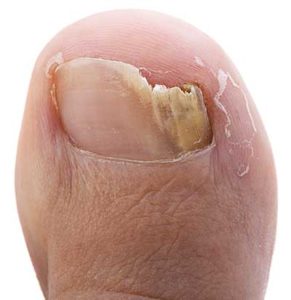How To Prevent Toenail Fungus
No one wants to experience toenail fungus (also called onychomycosis). However, it is relatively...
Over 46,000,000 Americans suffer from Nail Fungus ( Onychomycosis ) and 4,000,000 new cases are diagnosed each year.
 Nail fungus (scientific name onychomycosis [on-ih-koh-my-KOH-sis]), is a common condition that usually first appears as a discoloration, such as a white or yellow spot under the tip of the fingernail or toenail. As the fungus deepens, it may cause the nail to discolor, thicken, and crumble at the edge. An infection may spread to many nails, and often, it may appear concurrently with a skin fungus such as athlete’s foot (tinea pedis).
Nail fungus (scientific name onychomycosis [on-ih-koh-my-KOH-sis]), is a common condition that usually first appears as a discoloration, such as a white or yellow spot under the tip of the fingernail or toenail. As the fungus deepens, it may cause the nail to discolor, thicken, and crumble at the edge. An infection may spread to many nails, and often, it may appear concurrently with a skin fungus such as athlete’s foot (tinea pedis).
Fungal infection can vary in degree, warranting different levels and types of treatment. Cases which cause neither pain nor discomfort may require no special treatment at all. Those, by contrast, producing symptoms such as pain or a thickened nail may require specific types of self-care and or medication.
Even once successfully eradicated, however, fungal nail infections are likely to recur. Nevertheless, definite preventive measures can reduce the chance of re-infection.
Fungal nail infections occur when various fungal organisms (fungi) found naturally in, on, or under the nail overpopulate. The fungi that most commonly produce nail infection are called dermatophyte. Other fungi, however, such as yeast and molds, can likewise cause nail infection.
A variety of factors can contribute to the overgrowth of these fungi, which are already present in your body. Because fungi thrive in warm, moist environments, overpopulation most often occurs in areas of the body that are regularly covered and warm. For this reason, nail fungus is a higher risk factor more commonly affects toenails, for example, than fingernails.
The same fungi that cause nail infection can also cause jock itch, athlete’s foot, and ringworm. One type of infection, therefore, can lead to another. Athlete’s foot (foot fungus), for example, can spread to the nails, causing toenail infection. Fungal infections can also be communicated from one person to another.
Fungal nail infection can develop in people at any age, but it tends to appear more frequently among adults over the age of 65. This trend is likely due in part to the drier, thicker, and brittler condition of aging nails, which, if cracked or chipped, may allow fungi to enter.
Other factors may also contribute to higher rates of infection and more severe cases among older adults, including reduced blood circulation to the feet and a weakened immune system.
Certain conditions that increase the likelihood of developing a fungal nail infection, therefore, include the following:
Distinct behaviors that increase the risk of a nail infection include:

Simple lifestyle practices can help prevent fungal nail infection. The first and most important preventive measure is to keep your nails trimmed and clean.
Because other infections can attack the nail and mimic symptoms of fungal nail infection, the best way to confirm a diagnosis is to visit a doctor. Generally, the doctor will scrape or clip the nail to obtain a sample to examine under a microscope. In some cases, your doctor may send the sample to a lab for analysis.
If you have one or more of your finger nails or toe nails in a condition described below, you may have nail fungus:
Simple lifestyle practices can help prevent fungal nail infection. The first and most important preventive measure is to keep your nails trimmed and clean.
Other actions, such as avoiding injuring the skin around the nails and wearing rubber gloves while immersing the hands in water for an extended period of time, can also reduce the likelihood of infection.
Other ways to prevent fungal nail infection include:
From home remedies to oral medications, there are many ways to treat fungal infection, but it is difficult to eradicate the condition completely. Infection commonly recurs. Most treatments run the course of several months, in some cases up to 18. Even once you begin to see results, it is important to keep treating the infected area or taking dosage as prescribed.
Depending on the severity of an infection, various treatments may be recommended. For a less-invasive infection that you catch early on, you might consider trying one of the home-remedies or over-the-counter drugs listed below. For a more invasive, painful, or lasting infection, your doctor will likely recommend an antifungal drug, or possibly laser treatment.
To eradicate an infection successfully, you must be able to reach its source. Topical home remedies or over-the-counter drugs may be effective, therefore, if you are able to apply it directly to the fungus. Usually, however, the source remains inaccessible, buried beneath the nail or nail bed. Topical approaches, in the latter case, can be used to control an infection, but not to eliminate it.
If an infection is more deeply embedded or widespread, your doctor may prescribe a stronger antifungal medication, which may be either topical or oral. Oftentimes, a physician will recommend a combination of the two.
Topical drugs come in the form of polish, ointment, or sometimes aerosol spray, and they require several months of application on and around the infected area. While topical drugs can offer effective treatment at the onset of an infection, once the fungi have fully penetrated the nail and nail bed, they are less likely to be effective, and as a result, your doctor may prescribe an oral alternative.
Oral antifungal medications, which usually come in pill form, have the highest rates of success, but even these rates decrease in adults over 65. Oral drugs are also more expensive than most topical alternatives and carry with them a greater risk of side-effects, including skin rash and liver damage. Oral drugs should not be taken by those with liver disease or congestive heart failure.
For further information on the various treatment options, please consult the links below.
That’s awesome that there are many ways to treat fungal infections. My sister has been complaining about her feet itching a lot. We’ll have to look into nail fungus treatment.